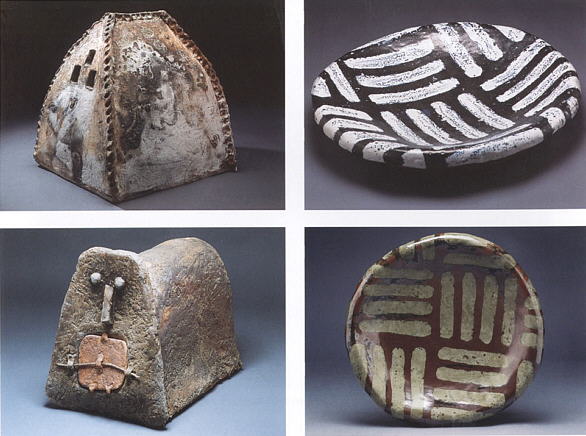A review from CERAMICS: Art & Perception, 2000 issue 42 by Karen Terpstra, republished with permission
 |
|
| ANCIENT CULTURES AND HISTORIC
INFLUENCES skillfully
cross boundaries between functional and sculptural objects in Gerry
Eskin's
clayworks. The Spirit of Clay exhibition at the American Craft Museum
in
New York. New York held December. 1999, through January, 2000, shows a
collection of his art covering the years 1992 to 1999.
Businessman, collector, teacher, Eskin as ceramist maintains a studio in Iowa City, Iowa, and Aspen, Colorado. His work pays tribute to forms and decoration of the ancient ceramics of Asia, the Middle East and the American Southwest. His Spirit Houses are wood-fired sculptures that recall ancient middle Eastern ossuaries (containers for the bones of the deceased) while his platters are inspired by 1000 year-old Mimbres and Anasazi ceramic artifacts in Eskin's own collection. His functional work is distinctive of classic Chinese and Japanese shapes with the simplicity of the Song and Edo periods.
|
The is always a danger of being so
immersed in
the history of a craft that one never achieves one's own style but
Eskin’s
imagination goes beyond this. His thorough grasp of ceramic history
unites
diverse ceramic periods in his art to that of the present. Eskin
cross-culturally
links different ceramic periods in his work, making the point that clay
is a particularly suitable material to do so and the point that the
contemporary
potter is allowed to use all of the history as a vehicle to admire,
appropriate,
absorb and transform.
Eskin’s treatment of form and the combination of enlarged symbolic repetition and geometric design lifts the platters from their historical context. They are successful in teasing us with an imaginary culture that defies categorisation. He resists specific links except in the use of pattern. Eskin’s functional forms are freshly created with a subtleness that pulls us back into the present, causing us to realise again that ceramists inevitably involve the history of the craft. |
|
Article by Karen Terpstra - Ceramics: Art and Perception No. 42 2000 - Pg 40 |
|
 |
|
| Top
left: Spirit
House. 1997 Sagger fired with wood. 47x54.5 x 53.5 cm.
Top Right: Large Platter. 1997. Basket pattern. 72.5 x 12 cm. Above left: Spirit House with door. 1998. Wood fored. 43 x 66 x 68.5 cm. Above right: Wall hanging platter. 1997. Basket pattern, kaki and celedon glaze 61 x 16.5 cm.. |
|
| Discussing the
concept behind the
Spirit Houses Eskin said the theme had originated with a number of
ancient
ossuaries he had seen on a trip to Israel in 1993. These ancient clay
burial
containers date from the Chocolithic period (4500-3300 BC) in the
Middle
East and are thought to be similar to contemporary spirit
houses.
The originals are similar in size and shape and have fronts with faces
and mouth-like openings. Various elements of decoration and symbols
appear
on the front part of the ossuary and are painted in red and black
oxides.
While the originals were made of low-fire terracotta, Eskin’s versions
are high-fired for three to five days in wood kilns; though they sit on
pedestals, they differ from their historical references – they face the
sky, as if offering sacrifices.
Gerry Eskin’s works achieve historical authority and skill and his incurable love affair with ceramic history offers us his vision of how contemporary clay can combine both without sacrificing either |
 1997. 48 x 18.5 cm. |
|
Karen Terpstra is Assistant Professor of Art/Ceramics at the University of Wisconsin – La Crosse Feb 2001 |
|